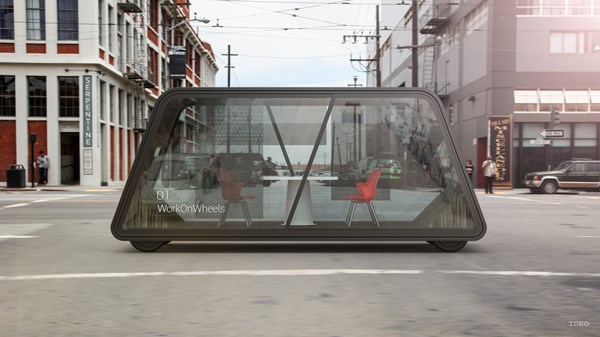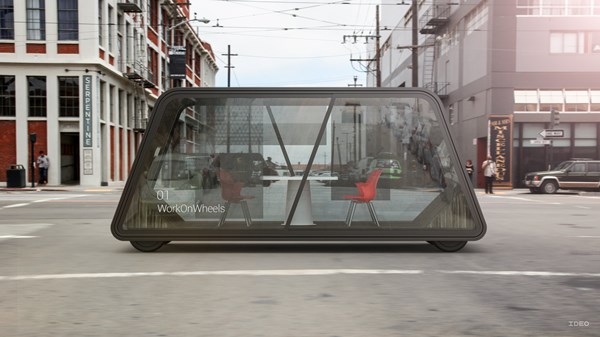Hannah Lina Mazzetti recalls the inconvenience of driving an hour from her home in rural Sweden just to buy a gallon of milk. Missing was a local corner store. So the 29-year-old public relations expert helped invent a modern substitute that can potentially drive and park itself.
Moby Mart stores are staffless modules with inventory, payment and security systems built in. Customers can unlock the stores with smartphone apps, shop and then check out — all without a storekeeper. Each of three models represents an early foray into what a growing number of designers are working to build: a future where spaces for retail, play and work will come to you — like autonomous cars, but bigger.
Space10, an Ikea-funded living future lab in Copenhagen that launched in 2015, last year unveiled its Spaces on Wheels program, with designs for seven different potential autonomous spaces. These vehicles range from an Ikea store on wheels to Play on Wheels, which would allow people to use augmented reality (AR) windows to play games that interact with their surroundings. If this sounds unrealistic, consider that in November 2017, Apple was granted a patent for AR displays that allow external objects to be viewed through a movable transparent window.

Through its Future of Automobility project, Ideo, a design firm with nine offices worldwide, is exploring designs for how people and spaces might be moved 15 years from now. The project envisages, among other ideas, office pods that can be summoned and parked, say, halfway between co-workers or on a pier, near a food truck. Co-founder Mazzetti’s Moby Mart, which launched in June 2017 with its first autonomous, moving store called the Moby Alpha, in January released a new, off-grid model: the solar-powered Moby Psi OTG (which fits inside a parking space).
It can be literally anything, from a self-driving office to a hotel to a self-driving farm.
Bas Van De Poel, creative director, Space10
At least 46 large corporations are investing in self-driving vehicles as of September 2018, according to CB Insights, a data-mining intelligence platform. And market analytics firm Allied Market Research is projecting a tenfold increase in the autonomous vehicle market in the U.S. alone, from $54.2 billion in 2019 to $556.7 billion in 2026. Bas Van De Poel, creative director of Space10, says mobile spaces comprise the logical next step in the driverless evolution. He compares self-driving platforms to iPhone apps, where anyone can build anything.
“It can be literally anything,” Van De Poel says, “from a self-driving office to a hotel to a self-driving farm.”
For sure, introducing these new vehicles to urban streets raises many of the same issues associated with regular autonomous cars — including safety and whether the vehicles will reduce our collective carbon footprint or add to it by moving previously fixed spaces.
Advocates for Highway and Auto Safety is one group calling for improved regulations. Catherine Chase, president of the nonprofit lobbying group, says she is hopeful about the promise of driverless vehicles — if the technology is proved to be safe. Citing Elaine Herzberg, a 49-year-old who was killed by a self-driving Uber in Arizona last year, Chase says that unlike people, who are required to take a vision test, autonomous vehicles aren’t required to have the capability to see and respond to what’s in the driving environment. “Say the brakes fail,” Chase says, “we need to make sure that the car can still pull over.”
.
Danny Stillion, partner and executive design director of Ideo, agrees that private industry and startups have to be “mindful and respectful” of those shaping public policy. The next hurdle, he says, is to “enlighten policy changes” in a way that enables the industry to thrive while creating prototypes of these new mobility experiences. Designers like Stillion and Van De Poel also hope to steer stakeholders away from the hypermasculine designs manufacturers currently present to something less aggressive and performance-focused and more human-centric.
Meanwhile, the Moby team is focused on the social justice aspect of mobile retail. “The retail industry is ruled by these really big brands, and we want to change that,” says Mazzetti. By circumventing expensive real estate and the need to employ help, she hopes anyone can turn a profit. But first, the law has to catch up.
For now, it’s not legal to operate fully autonomous vehicles anywhere. But once it is legal, Mazzetti says, it will be possible to incorporate the Alpha’s self-driving technology — currently undergoing beta-testing in Shanghai — into all three of the company’s models. In the meantime, she’s hoping to scale up production of the solar-powered Psi, which starts at $25,000. Albeit not yet on wheels, the prefabricated store can be shipped anywhere via container or on the back of a truck.
“The day fully autonomous vehicles hit the streets is the day that cars are not cars anymore,” says Van De Poel. At that point, anything is possible, in the same way the App Store enabled the advent of previously unimaginable services like Uber.
Equipped with solar panels and batteries, the low-energy Moby-Psi OTG shop could operate on its own for weeks, if necessary, with its owner watching by app as each bag of potato chips leaves its shelves. Mazzetti is convinced that advances in artificial intelligence don’t have to ruin our lives. It will take time to work out the various kinks, but once that’s done, AI may also save you travel time — and give you back a piece of your life currently spent on the road.

